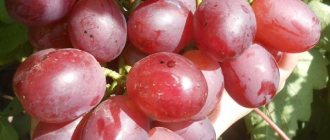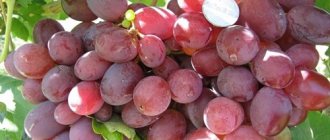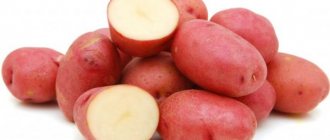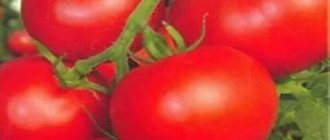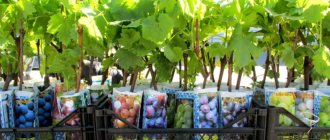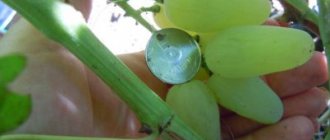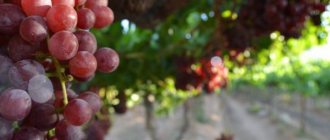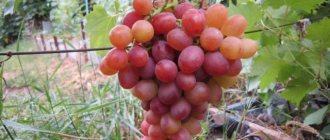A little about selection
Creating a new variety as a predictable stable trait is a difficult and time-consuming task.
After all, in order to determine the parameters of a new variety, a whole team of specialists has been studying and analyzing the leading characteristics of hybrid forms for 15 years, or even more, and selecting the best specimens for cloning.
Then comes the time for field testing in different climatic conditions.
The prototype ends up in the gardens of amateur gardeners, who also have a hand in improving the plant by selecting clones, and sometimes improve its gene pool through their own efforts.
Thus, by the time a new variety is registered in the State Register, several variants of hybrid forms may arise that have lost their resemblance to their common ancestors.
A plant acquires variety status only after being included in the State Register - the main document of innovative additions to winegrowers, and can exist in a hybrid form under different names for decades.
This happened with “Daria”, who received life in the selection laboratory of V.N. Krainov in Kuban. While it has not yet received variety status, it is being tested, and is, in the generally accepted understanding, a hybrid form.
Interesting: In the process of hybridization, any bisexual variety can be chosen as the paternal form, and the maternal one (after castration of the stamens) will be pollinated to produce hybrid seeds.
Among the hybrids, Jubilee of the Kherson Summer Resident, Korolek, Valery Voevoda and Gordey are widely popular.
Plant care
Despite the fact that the hybrid is unpretentious in care, that small part of the process of looking after the plant must be carried out efficiently. It is advisable to water the plant in the morning and evening, always with warm water. For each bush, 10–15 liters are allocated, which are poured into the rows, maintaining a distance of half a meter between watering and the base of the bush.
After irrigation, you need to loosen the soil and remove weeds that prevent the plant from developing. The time interval between waterings is 3 weeks; when it comes to the formation of flowers and berries, the interval is reduced to 10 days.
Fertilizers are applied in several stages during the growing season of the plant:
- intensive growth of shrubs - 20 l of a solution of potassium nitrate and water at a rate of 30 g:10 l, respectively;
- flowering period - 15 liters of superphosphate solution at the rate of 50 g of mineral fertilizer per 10 liters of water;
- fruiting phase - 20 liters of ammonia nitrate solution at a rate of 50 g:10 liters, respectively.
Young bushes are pruned in the spring, and long-lived plants - in the fall, using sharp pruning shears and at a right angle.
In the process, damaged shoots and withered branches are removed, as well as the “whiskers” of the bush, leaving no more than 5 eyes on each. Find out more about proper pruning of grapes in spring.
Pedigree of "Daria"
When creating a new varietal sample, Viktor Nikolaevich, first of all, solved the problem of developing resistance to the worst enemies of grapes - mildew and oidium.
And he relied on a proven interspecific hybrid created in the special nursery of VNIIViV - Keshu, which, as a result of 4 years of crossing, had already received immunity to fungal diseases.
The universal variety Druzhba (the fruit of cooperation between Novocherkassk and Bulgarian breeders), which is distinguished by the same high resistance to fungal diseases, was chosen as the other parent. In addition to these advantages, “Daria” received from her parents:
- from “Keshi”: high yield with early ripening; impressive size of cluster and berries; exceptional taste qualities of muscat varieties (8-9 points); excess of 5 times the percentage of sugar to the acid level; transportability and frost resistance;
- from “Friendship”: strong bush growth and early ripening; consumer quality of fruits (9.4 points), suitable for fresh consumption and production of sparkling wines; frost resistance down to -23°C.
Important: Pure varietal lines certainly lead to a drop in yield with a decrease in viability, therefore hybridization is the path to allopolyploidy.
Description of the variety
This hybrid form has a strong bush growth (up to 2.5 meters) and is characterized by:
- early ripening (until August 20);
- the release of powerful shoots with fruiting of 6-8 eyes;
- dark green, five-lobed leaves with deep slots and serrated edges;
- small hermaphrodite flowers of light green color, collected in a panicle; stamens are the male part of the flower, pistil is the female;
- large berries with a slight waxy coating, more than medium in size (up to 18g), amber in color (when fully ripe), with 2-3 seeds in a juicy pulp with a nutmeg taste;
- sugar accumulation in berries occurs throughout the season until full ripening and exceeds the acid content several times;
- assessment of taste on a tasting scale - between 8 and 9 points;
- with a heavy brush (up to 1 kg) of densely collected berries on a medium-sized comb, distinguished by its impeccable presentation;
- the peculiarity of fruits that are not subject to peas and cracking of the skin of ripe berries is that they are well stored (up to 1 month) and can withstand transportation;
- resistance to fungal infections up to 3 points;
- cold tolerance without shelter down to -23°C.
Interesting: The sweet taste of grapes - white, red, black - depends not so much on the variety, but on the degree of ripeness and sugar accumulation of the berries. Ripe grapes are always sweet!
Marcelo, Vostorg Muskatny, Dolgozhdanny and Aleshenkin Dar can also boast of high sugar accumulation.
How to grow grapes
Early ripening grape varieties, which include all 3 hybrid forms, are economically profitable to grow, since early products are in demand on the market and have a fairly high price, and are also effective from the point of view of agricultural technology - early ripening of the crop minimizes the risk of the bunches being damaged by fungal diseases.
Before planting a grape bush, you need to choose a suitable place for it on the site. It must be sunny, since for the rapid ripening of berries this plant needs the light and thermal energy of the sun. You also need to take care of protection from the wind - it is advisable to plant the bush near the southern wall of the building or fence. The soil for the vine should be light, fertile, airy, and well-drained.
The method of planting a young grape seedling depends on the type of soil on the site. Usually, on sand and sandy loam, plants are planted in trenches, and on loam and clay, and even with close groundwater, in raised ridges.
It is necessary to place seedlings on the plot correctly. Table variety bushes need a certain feeding area, so you need to leave enough space between them. It is necessary to plant Daria, Dashenka and Dashunya grapes according to the following scheme:
- between bushes in a row - at least 1.5 m;
- between rows – 2-2.5 m.
It is better to place seedlings in planting holes not vertically, but laying them as low as possible, at the maximum possible angle. This will further enable the vine to ripen better.
It is better to cover young grape seedlings for the winter in the first 1-2 years of the growing season, despite the fact that they have good frost resistance. It is especially necessary to do this in the northern regions in order to protect the fragile vine from freezing. It must be removed from the trellis and hidden under reliable covering material. You can put boards or spruce branches under the bottom, and cover the shoots with a layer of agrofibre, film, roofing felt, etc. on top. You need to close it loosely and leave small gaps for ventilation.
It is necessary to water the bushes regularly only in the first year of their life so that they take root well. For older grape plants, watering should be carried out 3 times per season:
- 2 weeks before flowering begins (it is better not to water later, because excess moisture can cause color shedding and delay the ripening of the expected harvest);
- after flowering (watering should be stopped when the berries begin to color);
- moisture-recharging irrigation in late autumn.
You need to pour water not at the root, but between the rows or no closer than 0.5 m from the base of the bush. There is no need to sprinkle: diseases develop faster on a damp leaf.
Attention! It is better to tie fruiting arrows horizontally rather than vertically.
In this case, all green shoots will grow along their entire length, and not mainly from the upper eyes, which often happens with a vertical garter.
Pruning of Daria, Dashenka and Dashunya grapes should be done in a timely manner, but sparingly. In the first year, no pruning is carried out. On mature bushes, you should not cut off all the shoots and tops at once. After the procedure, wintering buds may begin to grow on such plants, and this will significantly weaken them. The stepsons should not be broken out, but left 1-2 leaves on them. It is best to prune in the fall, after the grape leaves begin to fall off and the night temperature drops to below freezing. In spring, it is better to prune shoots on young bushes: an unpruned vine tolerates cold better than a trimmed one.
It will take several years to form a grape bush. It can be grown in the classic way - on a trellis, or planted near a canopy or small buildings so that it can entwine them. From a powerful, strong grapevine, you can cut cuttings for propagation and thus increase the number of bushes of the variety you like on your site.
Advice! In order for grape plants to grow and bear fruit well, they need proper care. For its proper organization, it is advisable to record information about what agricultural activities were carried out and when. This will allow you to create more correct work with the vine.
Hybrid "Dasha" - relatives or friends?
Most likely a friend. Since the hybrid was created through the efforts of the Potapenko VNIIViV together with Zaporozhye breeders. Therefore, the table variety Podarok Zaporozhye was taken as the basis for the parent pair, which has the following qualities as a “dowry”:
- high productivity;
- average ripening period for large (up to 1 kg) brushes;
- fixed immunity to oidium and mildew;
- simple taste of green berries (20% sugar content);
- frost resistance within - 24°C.
The mother plant was the white table variety Arcadia (Ukrainian selection) - vigorous and large-fruited, but with a lower resistance to rot, and mandatory protection of the frost-vulnerable bush in the cold season.
The variety's maternal gift is recognized as: golden-colored berries with a muscat taste, collected in powerful clusters weighing up to 2 kg.
“Dasha” has a specific creator - Vitaly Vladimirovich Zagorulko, a Zaporozhye amateur breeder who laid the foundation for his collection back in the 90s of the last century, collecting more than 30 new hybrid forms of grapes.
Asya, Ruta, Vodograi and Viking also belong to his hand.
Interesting: Winegrowers have something to strive for: the record weight of a bunch was registered at the end of the last century in Chile - 9,500g.
Harvesting cuttings
Description and characteristics of the Imant apple tree, planting and growing rules
If you want your vineyard to become much larger, or plan to share the plant with neighbors or friends, you can take cuttings yourself. To do this you need to do a little work:
When pruning grapes in November, you need to select vines that are as thick as your little finger and that are well-ripened. Cut it into pieces, which should have 2-4 buds. Soak the cuttings in water for about a day. Then dry it a little. Wrap in damp paper and place in a plastic bag. It should have holes for good ventilation. Packaged cuttings should be stored in a cool place - in the refrigerator or cellar. Can be buried in the ground to a depth of 20 cm
It is important to ensure that there is no stagnation of moisture in the area.
In the spring, before planting, the cuttings should be awakened and rooted. This is a simple procedure and does not require special skills. Some manipulations need to be done:
- Using pruning shears, trim the ends of the cuttings and immerse them in water for two days.
- You can add aloe juice, flower honey to the liquid, or purchase special preparations in the store.
- After this, we take out the blanks and again update the sections and make longitudinal cuts along the bottom of the cutting.
- After all the procedures, we immerse the cuttings in a container, and within two weeks the first leaves will appear. And after three to four weeks, roots will form.
- The plant is ready for planting.
Experienced gardeners opt for hybrid forms of grapes, characterized by good yield and other excellent qualities. As a result of mixing the grapes “Kesha 1”, “Kishmisha radiant” and “Rizamat”, the Ukrainian breeder N.P. Vishnevetsky created the Dashunya variety. This variety should not be confused with the Dasha and Daria varieties.
A description of the plant helps to understand the characteristics and at the same time make the right choice.
Hybrid form of Dashun ripening on a bush
Characteristic features of the variety
The description of Dashun grapes allows you to get acquainted with the characteristic qualities of the variety:
- Early ripening (115 days). The timing becomes active in the 2-3rd year of fruiting.
- High yield. One bunch can reach 1.5 kg.
- Good resistance to fungal diseases (oidium, mildew). The crop is not attacked by wasps.
- Moisture resistance. At high humidity, the berries retain their presentation.
- High frost resistance. The plant can withstand frosts down to -23⁰ C without covering the bushes.
- Excellent transportation. Transportation does not affect consumer qualities.
- Long shelf life.
Dashuni brush, medium size, loose
Description of external signs
External description of Dashun grapes:
- Vigorous bushes reaching 3 meters. Powerful shoots quickly take root.
- The leaves are large in size, dark green in color.
- Medium density conical brush.
- Fleshy, juicy berries with a pleasant nutmeg. The berries are round in shape and dark pink or even reddish in color.
Feature of pollination
An important feature of Dashun is the female type of flower. Underdeveloped stamens contain sterile pollen. Special pollination is carried out by bisexual neighbors, whose flowering period must coincide. This procedure is carried out using a brush.
The female type of Dashuni flower requires artificial pollination
Features of this type
Powerful bush constitution, with strong shoots.
- Variation in terms of ripening: early and middle.
- Excellent selection qualities of the rootstock and engraftment of shoots during cuttings.
- The leaf is five-lobed with a serrated edge.
- Flowers are bisexual, collected in inflorescences.
- A dense oval berry with a pruin, characterized by the exquisite taste of muscat varieties and 22% sugar content.
- The clusters are large, medium density, conical in shape, on a short comb.
- The fruits remain marketable until early November.
- Resistance to diseases - 2.5-3 points.
- Without shelter it tolerates temperatures down to -23°C.
Reference: Grape resistance to fungal diseases is determined on a five-point scale, with “5” being the lowest level of plant immunity. The ideal should be “1”, but - alas, this indicator is not yet achievable; winegrowers have to rejoice at the value of 2 and 2.5.
Photo of Dasha grapes:
Landing of Dashuni
After we have reviewed the description of the Dashun grape variety, you need to know some rules on how and where to plant it.
The grapes need to be placed in a place where the plant will receive a large dose of sunlight. Young grapes should be planted according to a 1.5 by 2 meter pattern. Planting more frequently will reduce the supply of nutrients. Seedlings should be immersed in the hole at an angle, this will help the shoots to ripen well. The support for the vine will be a garden gazebo, the wall of a house, or you can make an arch, which in the summer will serve as a shelter from the sun and will become an excellent decoration of the garden landscape.
Who is “Dashunya”?
“Dashunya” appeared on a 30-acre plot of land near Kiev.
The creator of this interspecific hybrid was a breeder from the people who improved the plants in his garden, first of all, for his family: for taste, winter hardiness, and resistance to fungal diseases.
It was now, when his seedlings had dispersed far beyond the Volga, that they began to say: “The collection of Nikolai Vishnevetsky. Breeding sample of Vishnevetsky.”
Fans began to look on the Internet for a way to contact the author in order to get his hybrid. Nikolai Pavlovich responds to many with regret that it is now impossible to send cuttings to Russia, unless sent by opportunity or self-pickup - the international situation.
Who did Nikolai Pavlovich choose as “Dashune’s” parents:
Kesha 1 - this is a family connection with Daria!
- Radiant raisins. Crossing these two varieties has already once produced at VNIIViV Novocherkassk the “Kesha Radiant” variety with a reduced number of seeds in the berry.
- Rizamat (Uzbek selection) is a table and raisin grape with a very high fructose content, early ripening and impressive yield - up to 250 c/ha. True, the parent was inferior to the other two in resistance to mildew, but had a beautiful rich pink color of the bunch.
You can already imagine all the advantages of the newly-minted “Dashuni”:
- beautiful decorative color of brushes;
- fleshy fruits with nutmeg taste;
- desirable resistance to fungal infections.
Interesting: Using the examples of the described varieties, you can see how far they have advanced to the north of Russia. Now the border of their range runs: Kamennogorsk - Vologda - Yekaterinburg.
Diseases and pests
Plants of the Dashenka variety are often affected by gray rot, mildew and oidium. A solution of Bordeaux mixture (3 g per 10 liters of water) helps to get rid of gray rot. In the fight against mildew and oidium, spraying with a homa solution (30 g per 10 liters of water) is used.
The only pest that affects plants is aphids. An oxychome solution (50 g per 10 liters of water) helps to effectively combat it. Spraying is carried out at intervals of 10 days.
As a preventative measure, care procedures are followed: timely weeding and loosening of the soil. Spraying bushes with copper sulfate increases the plant's resistance to diseases and pests.
